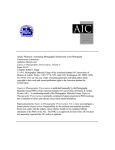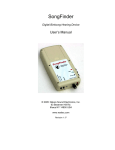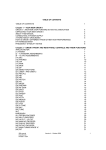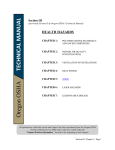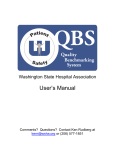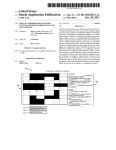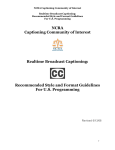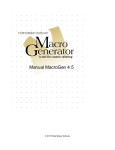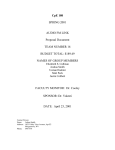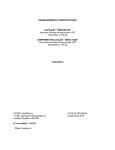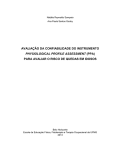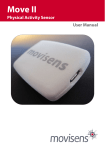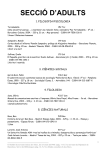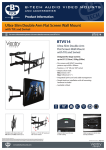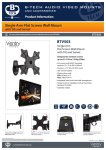Download Nursing Management of Hearing Impairment in Nursing Facility
Transcript
Evidence-Based Guideline Nursing Management of Hearing Impairment in Nursing Facility Residents H earing impairment is a serious problem among older adults in America. It affects their functional ability, which in turn significantly affects their quality of life (U.S. Administration on Aging [AOA], 2002). Hearing impairment is one of the most prevalent chronic conditions among older adults, exceeded only by arthritis, heart disease, and hypertensive disease (U.S. AOA, 2002; National Center for Health Statistics, 2008; National Institutes of Health [NIH], 2007). Hearing loss, which leads to hearing impairment, is the most common sensory deficit in older adults. One in three people older than age 60 and half of adults older than 85 have hearing loss, leading to hearing impairment (Kennedy-Malone, Fletcher, & Plank, 2004). The prevalence of hearing impairment among older adults in nursing homes is even greater (Kennedy-Malone, Fletcher, & Plank, 2004). Up to 98% of older adults residing in long-term care facilities have hearing impairments (American Speech-Language Hearing Association [ASHA], 1997; “Considerations in Screening,” 1992; Norwood-Chapman & Burchfield, 1999). Although the prevalence of hearing impairment is significant, RNs, tion. It is available at http://www. nursing.uiowa.edu/products_ services/evidence_based.htm. PURPOSE licensed practical nurses (LPNs), and certified nursing assistants (CNAs) in nursing facilities often feel inadequately prepared to care for those who are hearing impaired (Heron & Wharrad, 2000; Wilson & Rodgers, 2000). Given the prevalence and significant consequences of hearing impairment, it is important that nurses adequately manage hearing impairment in nursing facility residents. This article is a condensed version of the published practice guideline entitled Nursing Management of Hearing Impairment in Nursing Facility Residents. Readers are encouraged to obtain the full guideline, which contains additional essential informa- The purpose of this evidencebased practice guideline is to provide guidelines for the nursing care of nursing facility residents with hearing impairment. The guideline is intended for frontline nursing staff (RNs, LPNs, and CNAs) caring for older adults who are hearing impaired. This guideline will also be useful for directors of nursing, nurse managers, and nursing faculty responsible for gerontological nursing competency evaluations and education on standards of nursing care for hearing impairment in older adults in nursing facilities. The goal of this evidence-based practice guideline is to improve the quality of life for nursing facility residents with hearing impairment. DEFINITIONs OF KEY TERMS Hearing is the sense that enables sound to be perceived (Mosby’s Medical, Nursing, & Allied Health Dictionary, 2002). Hearing loss is the decreased ability or complete inability to hear the normal range (20 to 25 dB Written by Linda Adams-Wendling, PhD, RN, CNAA-BC, CNE; and Cathy Pimple, MS, ARNP Edited by Susan Adams, PhD, RN; and Marita G. Titler, PhD, RN, FAAN Journal of Gerontological Nursing • Vol. 34, No. 11, 2008 Table 1 Bedside Hearing Impairment Assessment/Screening Instruments Tool Abnormal Findings Selected References 0 to 8 = no hearing handicap 9 to 24 = mild to moderate hearing handicap 25 to 40 = severe hearing handicap Conductive, sensorineural, or mixed hearing loss Administer in a quiet setting to cognitively intact residents at admission, quarterly, annually, and with a significant change. Scudder, Culbertson, Waldron, & Stewart (2003); Sindhusake et al. (2001); Wiley, Cruickshanks, Nondahl, & Tweed (2000) Nursing Home Hearing Handicap Index (NHHI) (Schow & Nerbonne, 1980) 0 to 20 = no hearing handicap 21 to 40 = slight hearing handicap 41 to 70 = mild to moderate hearing handicap >71 = severe hearing handicap Conductive, sensorineural, or mixed hearing loss Administer in a quiet setting to cognitively intact residents at admission, quarterly, annually, and with a significant change. Scudder, Culbertson, Waldron, & Stewart (2003); Sindhusake et al. (2001); Wiley et al. (2000) Minimum Data Set (MDS) 0 = normal answers 1, 2, or 3 = abnormal Conductive, sensorineural, or mixed hearing loss Administer in a quiet setting at admission, quarterly, annually, and with a significant change. Centers for Medicare & Medicaid Services (2003); Sindhusake et al. (2001) Hand-held audioscope (25 to 40 dB pure tone at 500 Hz, 1000 Hz, 2000 Hz, and 4000 Hz; test tone = 60 dB) Hearing is considered normal if sounds from 250 through 8,000 Hz can be heard at volumes of 25 dB or less. Conductive, sensorineural, or mixed hearing loss In a quiet environment, ask the patient to make a fist with one hand. Instruct the patient to identify when they hear a sound by raising a finger or saying yes. Present pure tones of random loudness (in dB). American Speech-Language-Hearing Association (1997, 2002); Bagai, Thavendiranathan, & Detsky (2006); Gates, Murphy, Rees, & Fraher (2003); Wallhagen, Pettengill, & Whiteside (2006); Yueh, Shapiro, MacLean, & Shekelle (2003) Otoscope Obstruction or damage to external or middle ear Conductive hearing loss Insert and inspect ear canal and tympanic membrane. Dillon (2003); Jarvis (2004) Whisper test Able to hear (>50%) combination of whispered numbers, letters, or words at 1 to 2 feet or less Conductive, sensorineural, or mixed hearing loss In a quiet environment, stand arm’s length behind seated resident. Whisper in one ear and ask the resident to repeat what was whispered. The ear not being tested should be masked or occluded. Repeat with opposite ear.a Bagai et al. (2006); Wallhagen et al. (2006) Rinne test Bone conduction greater than air Conductive or mixed hearing loss Place a vibrating tuning fork (256 Hz or 512 Hz) on the resident’s mastoid process. If the resident is unable to hear sound (record number of seconds), place tuning fork 1 inch from external auditory canal and record time sound is heard. Compare bone to air conduction. Dillon (2003); Jarvis (2004) Place a vibrating tuning fork (256 Hz or 512 Hz) firmly on top of the resident’s head or forehead. Ask the resident if the vibration sounds the same in both ears or different. Dillon (2003); Jarvis (2004) Air conduction greater than bone but <2-to-1 ratio Weber test Sound lateralizes to impaired ear Sound remains equal = normal Sound lateralizes to normal ear Sensorineural hearing loss Sensorineural hearing loss See the full guideline for further instructions. or lower; 20 to 20,000 Hz) of sounds audible to an individual with normal hearing (Bagai, Thavendiranathan, & Detsky, 2006). The loss may in- 10 Key Procedure Steps Hearing Handicap Inventory for the Elderly-Screening (HHIE-S) (Ventry & Weinstein, 1983) Air conduction twice as long as bone conduction = normal a Kind of Hearing Impairment volve the external, middle, or inner ear and can be unilateral or bilateral (Wallhagen, Pettengill, & Whiteside, 2006). Hearing impairment refers to hearing loss and/or the abnormality of anatomical structure or function of the auditory system that adversely affects an individual’s ability to com- JOGNonline.com municate (Mosby’s Medical, Nursing, & Allied Health Dictionary, 2002). There are three major categories of hearing loss in older adults: l Sensorineural hearing loss is the result of damage to the inner ear, including the cochlea or auditory/eighth cranial nerve. Common causes include birth-related causes; heredity; viral or bacterial infections; mumps; spinal meningitis; encephalitis; trauma; tumors; noise; hypertension; coronary artery or vascular disease; ototoxic drugs, including aminoglycosides, diuretics, some antibiotics, and cancer medications; and Meniere’s disease (National Institute of Neurological and Communicative Disorders and Stroke [NINCDS], 1982, 1984). l Presbycusis, the most common kind of hearing impairment in older adults, is defined as a sensorineural loss caused by changes in the inner ear (Bagai et al., 2006; Gates & Mills, 2005). Presbycusis is the term most often used to describe hearing impairment that is age related and generally presents as a gradual and progressive bilateral deafness. With presbycusis, there is a loss of highpitched tones (1,000 to 8,000 Hz) in acuity, auditory threshold, speech intelligibility, and pitch. Consonants such as f, sh, ch, h, t, p, and s are high-frequency sounds that become inaudible with presbycusis, resulting in the inability to comprehend words (Bagai et al., 2006; Brender, Burke, & Glass, 2006; Wallhagen et al., 2006). l Conductive hearing loss results from a physical disruption in the transmission of sound waves through the external or middle ear (Ignatavicius & Workman, 2006; Wallhagen et al., 2006). Causes of conductive hearing loss include external blockage, perforated eardrum, genetic or congenital abnormality, otitis media, and otosclerosis (Bagai et al., 2006; Wallhagen et al., 2006). The most common cause of conductive hearing loss in older adults is buildup of cerumen in the auditory canal (Wallhagen et al., 2006; Zivic & King, 1993). As individuals age, cerumen becomes drier, and the cilia become coarse and stiff, reducing their function and causing cerumen buildup (Zivic & King, 1993). Cerumen impaction obstructs sound transmission and can cause up to a 40 to 45 dB loss (Meador, 1995; Zivic & King, 1993). The estimated incidence of cerumen impaction in nursing home residents is nearly 40% (Freeman, 1995). Mixed hearing loss includes both conductive and sensorineural components (Bagai et al., 2006; KennedyMalone et al., 2004). In other words, there may be damage in the outer or middle ear and in the inner ear (cochlea) or auditory nerve. INDIVIDUALS AT RISK FOR HEARING IMPAIRMENT Risk factors for hearing loss leading to hearing impairment include: l Age older than 65 (Wallhagen et al., 2006). l Residence in nursing facilities (Garahan, Waller, Houghton, Tisdale, & Runge, 1992). l Cognitive decline (Cacchione, Culp, Dyck, & Laing, 2003; Strouse, Hall, & Burger, 1995). l Visual impairments (Crews & Campbell, 2004; Rudberg, Furner, Dunn, & Cassel, 1993). l History of chronic otitis media (Yueh, Shapiro, MacLean, & Shekelle, 2003). l Excessive noise exposure (Brookhouser, 1994; Mayo Clinic, 2007; Morata, 1998). l Use of ototoxic medications (Begg, Barclay, & Kirkpatrick, 2001; Palomar, Abdulghaini, Bodet, & Andreu, 2001). l Male gender (U.S. AOA, 2002; Garstecki & Erler, 1999; NIH, 2007). Older individuals frequently exhibit several of these risk factors simultaneously and are at an increased risk for hearing impairment. ASSESSMENT CRITERION Because of the high prevalence of hearing loss in nursing facility resi- Journal of Gerontological Nursing • Vol. 34, No. 11, 2008 dents, all residents should be evaluated for hearing impairment on admission and on an ongoing basis (e.g., significant change in status or as needed, but minimally on an annual basis) (ASHA, 1997; Bagai et al., 2006; Centers for Medicare & Medicaid Services, 2003). ASSESSMENT TOOLS Several bedside assessment tools are available for RNs to screen and assess for hearing impairment in nursing facility residents. The most common assessment instruments include: l Hearing Handicap Inventory for the Elderly-Screening (HHIE-S) (Ventry & Weinstein, 1983). l Nursing Home Hearing Handicap Index (NHHI) (Schow & Nerbonne, 1980). l Minimum Data Set (MDS) assessment. l Hand-held audioscope. l Otoscope. l Whisper test. l Rinne and Weber assessment tests (Dillon, 2003; Jarvis, 2004). Descriptions and directions for use of these screening/assessment instruments, abnormal assessment findings, and kinds of hearing impairment are shown in Table 1. Screening/Assessment The nursing hearing impairment screening evaluation should consist of a thorough history and physical examination, which are essential to the diagnosis and treatment of hearing impairment. The history and physical examination should minimally consist of a self-report evaluation (including an interview of the resident’s family) and screening for hearing impairment with the MDS. In addition, the HHIE-S or the NHHI are recommended for screening cognitively intact residents for hearing impairment. The physiological evaluation should include examining the external auditory canal with an otoscope for cerumen, foreign bodies, and abnormalities, and screening for hear- 11 ing impairment with a hand-held audioscope. If a hand-held audioscope is not available or if the RN completing the assessment has not been trained on the use of an audioscope, then the Whisper test can be used. All nursing facility residents with suspected hearing problems or abnormal screenings for hearing impairment should be referred to the primary care provider to initiate interventions (e.g., cerumen management) and to an ear, nose, and throat (ENT) physician and/or audiologist for audiometric evaluation, hearing diagnosis, and hearing rehabilitation. DESCRIPTION OF PRACTICE Nursing interventions carried out for individuals with hearing impairment consist of communication strategies, hearing aids and assistive listening devices, and cerumen management. Communication Hearing impairment has a profound effect on nursing facility residents’ communication abilities. Nursing staff can contribute to the physical and emotional well-being of residents with hearing impairments by becoming sensitive to their needs. Table 2 provides a synthesis of recommendations found in the literature related to key communication strategies. Hearing Aids and Assistive Listening Devices Hearing aids and assistive listening devices (ALDs) have been reported to significantly improve quality of life (Appollonio, Carabellese, Frattola, & Trabucchi, 1996; National Council on the Aging, 1999). All nursing personnel are responsible for the care and management of these devices, yet many nursing staff have not received formal training regarding hearing aids and ALDs and thus lack knowledge about proper care and management (Jennings & Head, 1997; NorwoodChapman & Burchfield, 1999). 12 Table 2 Strategies to Communicate with Nursing Facility Residents with Hearing Impairment Note the resident’s preferred communication method • Note that this may be verbal, written, lip reading, or American Sign Language. • Ensure this preference is evident on the resident’s care plan, available to all nursing personnel. • Explore with resident, family, or legal responsible party the availability of and process to acquire assistive listening devices and hearing aids, if needed. Face the resident directly • Be sure to look directly at the resident, preferably at eye level, before starting to speak. • If the resident wears a hearing aid, ensure it is secure in the correct ear and turned on. • Check for visual impairment; ask “Can you read a newspaper?” If the resident wears eyeglasses, ensure the glasses are on and clean. • Know that the resident must be able to see you to hear you. • Establish eye contact. • Do not turn away in the middle of a sentence. Avoid noisy backgrounds • Understand that a conversation is difficult to hear over background noises because the sound is coming from all sides. • Ask the resident to sit with his or her back to the wall so sound is not coming from all sides. • Do not try to talk above loud noises; this makes hearing more difficult. • Ask residents to suggest things you can do to facilitate communication, such as speaking toward a better ear or moving to a better lighted area. Spotlight your face • Face a window or a lamp so the light illuminates your mouth as you speak. • If the room is dark, move to another area with better lighting. • Recognize that residents with hearing loss often rely heavily on lip reading. Give clues when changing subjects • Do not change the subject without warning, as it may confuse the resident. • Keep the resident on track with phrases such as, “Now I want to talk to you about our upcoming family night,” so the resident can become ready for a new topic. Keep it simple • Use plain, simple English (or the resident’s primary spoken language). • Avoid slang. • Rephrase the idea in short, simple sentences if the listener does not respond. • Evaluate or verify what you have said or written using the resident’s response before you continue. Training nursing personnel on the use, care, and maintenance of hearing aids and ALDs is vital to providing quality nursing care to residents with hearing impairment. Table 3 provides key use, care, and maintenance information that all nursing personnel caring for residents should know about hearing aids and ALDs. Hearing Aids: Types, Care, and Maintenance. A hearing aid is a battery-powered, sound-amplifying device used by residents with hearing impairment. It consists of a microphone that picks up sound and converts it to electric energy, an amplifier that magnifies the electric energy, a receiver that converts the amplified energy, and an ear mold that directs JOGNonline.com Table 2 (continued) Strategies to Communicate with Nursing Facility Residents with Hearing Impairment Gain the resident’s attention first • Be sure the resident is aware of you before you start talking. • If the resident is turned away from you or turns away from you, alert the resident with a gentle touch. Communicate • Speak in a quiet environment, not farther than 2 to 3 feet away from the resident. • Ensure only one person at a time is talking to the resident. • Allow adequate time for the resident to listen and respond. • Say the resident’s first name and then continue the sentence. • Use gestures if you need to clarify a statement or question. • Do not chew gum or cover your mouth when speaking. • Do not hold anything in your teeth. • Use written communication if unable to communicate verbally. Do not shout • Note that shouting makes hearing more difficult and may be painful to the resident. • Understand that shouting distorts the speaker’s face and makes lip reading difficult or impossible. • Recognize that when shouting is amplified by a hearing aid, it can frighten and upset the resident. • Do not speak directly into the resident’s ear, as this prevents the resident from using visual cues. Speak clearly at a moderate pace • Speak slowly and pause occasionally to help the resident keep up with the word flow. • Enunciate each word carefully and avoid mumbling. • Do not “mouth” or exaggerate expressions, as this makes it more difficult for the resident to understand. • Do not use a high-pitched tone; use a lower, deeper voice. • Do not use “baby talk.” Use longer phrases • Understand that longer phrases tend to be easier for residents to understand and provide more “meaning” clues than do shorter phrases. For example, “Will you get me a drink of water?” presents less difficulty than does “Will you get me a drink?” Beware of listener bluffing • Know that when it is too difficult to listen, some residents may agree with everything, even when they do not understand what is being said. the sound into the ear (Kozier, Erb, Berman, & Snyder, 2003). For proper functioning, it is necessary that caregivers handle the hearing aid appropriately during insertion, removal, regular cleaning, and battery replacement. There are several different kinds of hearing aid devices. A common one is the behind-the-ear or postaural aid. This kind fits snugly behind the ear, and the hearing aid case holds the microphone and amplifier, with the receiver attached to the earmold by a plastic tube. Another widely used device is the in-the-ear or intra-aural aid. This one-piece aid contains all of the components within the earmold. Other hearing aid devices include the in-the-canal aid, the completely Journal of Gerontological Nursing • Vol. 34, No. 11, 2008 in-the-canal aid, eyeglasses aid, and body hearing aid (Kozier et al., 2003; Wallhagen et al., 2006). The manufacturer’s specific guidelines should be followed for proper hearing aid use, care, and maintenance. ALDs: Types, Care, and Maintenance. ALDs are any kind of device other than hearing aids used to help individuals with hearing impairment function better in daily communication. ALDs are appropriate for older adults with mild to moderate hearing loss because these devices can provide satisfactory auditory function without the use of a hearing aid. In addition, ALDs may be used with hearing aids; when they are, they may tune out bothersome background noise (Jerger, Chimiel, Florin, Pirozzolo, & Wilson, 1996). Unfortunately, people with hearing impairment often resist using these visible devices (ASHA, n.d.; Jupiter & Spivey, 1997). The following are examples of common categories of ALDs: l Pocket talker or hardwire devices are composed of a microphone that the speaker talks into, an amplifier to make the sounds louder, and a wire leading to earphones worn by the resident. The earphones have adjustable volume. These kinds of ALDs are simple to use and appropriate for engaging in one-on-one conversation, watching television, and listening to the radio. However, due to the wire connection, this kind of ALD may be too restrictive for large group conversations. l With personal frequency modulation, the speaker wears a small microphone, and signals are transmitted along a radio frequency carrier wave to the amplifier, which is worn by the resident. The personal frequency modulation system can be used for personal use or in larger areas. l In infrared systems, a microphone picks up energy from the speaker, converts it, and transmits it to an infrared converter. The converter transmits the signal on an 13 infrared carrier beam. The listener wears a receiver, which looks like lightweight earphones. This kind of system allows residents to be involved in group activities or to watch television in a lounge area. However, this kind of system cannot be used in direct sunlight. l The induction loop system consists of a microphone, amplifier, and wire that surround a designated area. The microphone near the speaker transmits the signal to the wire, and the signal is picked up by the hearing aid. However, fluorescent lighting may cause interference, and the resident must be sitting within the area of the loop. l Other ALDs include telephone amplifiers, amplified answering machines, paging systems, computers, and wake-up alarms. Cerumen Management Cerumen removal is indicated when cerumen blocks the external auditory canal, resulting in hearing loss, pain, or infection (Freeman, 1995; Kozier et al., 2003). Methods to remove cerumen impaction include both ceruminolytic agents and aural lavage/irrigation (which is discussed in the full guideline). Removal must be performed by a trained RN with a physician’s order (Cook, 1998; Grossan, 1998; Rodgers, 1997; Stubbs, 2000; Thurgood & Thurgood, 1995). Only a physician or an advanced practice nurse should remove impacted cerumen under direct vision and a curette. Although ear irrigations are reportedly a common procedure for cerumen management (ASHA, 2002; Dinces, 2008; Sinclair, 2005), they are invasive and have the potential to cause discomfort or even injury to the resident. RNs must achieve competence in aural lavage/irrigation prior to performing the procedure. Aural lavage is contraindicated if the resident has a perforated tympanic membrane, acute or chronic otitis media, otitis externa, myringotomy tubes, or a mastoid cavity 14 Table 3 Care and Maintenance of Hearing Aids and Assistive Listening Devices Hearing Aid General Care and Maintenance Remove the Hearing Aid: 1. Turn the hearing aid off and then lower the volume. The on/off switch may be represented by an O (off ), M (microphone), T (telephone), or TM (telephone/microphone). If the hearing aid is not turned off, the batteries will continue to run. 2. Remove the earmold by rotating it slightly forward and then pulling it outward. 3. Remove the battery if the hearing aid will not be used for several days. This prevents corrosion of the hearing aid from battery leakage. 4. Store the hearing aid in a safe place, away from heat and moisture. Safe storage prevents loss or damage. Clean the Earmold: 1. Detach the earmold as indicated. Disconnect the earmold from the receiver of a body hearing aid or from the hearing aid case of a behind-the-ear or eyeglasses aid where the tube meets the hook of the case. Do not remove the earmold if it is glued or secured. Removal helps in cleaning and prevents damage to the hearing aid. 2. If the earmold is detachable, soak it in a mild soapy solution. Clean the earmold, rinse, and then dry with a soft cloth. Do not use isopropyl alcohol, solvents, or oil. Alcohol may damage the hearing aid. If the earmold is not detachable or is for an in-the-ear aid, clean the earmold with a damp cloth. 3. Check that the earmold opening is patent. Remove any excess moisture or debris with a soft cloth or cotton ball. Then reattach the earmold to the rest of the hearing aid. INSERT THE HEARING AID: 1. Ask the resident whether the earmold is for the left or right ear. Check for correct battery placement. Ensure the hearing aid is turned off and the volume is turned down. Line up the parts of the earmold with the resident’s ear. Slightly rotate the earmold forward and insert the ear canal portion. Gently press the earmold into the ear while rotating it backward. 2. Check that the earmold fits snugly by asking the resident if it feels secure and comfortable. Adjust the other components of the hearing aid as applicable. 3. Turn the hearing aid on and adjust the volume according to the resident’s needs. Troubleshoot Problems: 1. If the sound is weak or absent: a. Ensure the volume is turned up. b. Ensure the earmold opening is not clogged. If the opening is clogged, gently push it out with a pin or pipe cleaner. If the hearing aid is one that sits in the ear, the receiver opening is lined with a piece of tubing that can easily be mistaken for cerumen. The resident should have a little tool called a wax loop, which should be used to remove the cerumen. c. Check the battery by turning the hearing aid on, turning up the volume, cupping your hand over the earmold, and listening. A constant whistling sound indicates the battery is functioning. A weak sound may indicate the battery is losing power. Replace the battery as necessary. (Cook, 1998; Lewis-Cullinan & Janken, 1990; Thurgood & Thurgood, 1995; Zivic & King, 1993). Residents with any of these conditions should be referred to an ENT physician for cerumen removal (Meador, 1995). If JOGNonline.com Table 3 (continued) Care and Maintenance of Hearing Aids and Assistive Listening Devices d. Ensure the negative and positive signs on the battery match those indicated on the hearing aid. Be sure the new battery fits snugly but comfortably into its compartment. If there is resistance, either the battery is the wrong size or it is being inserted the wrong way. It may be helpful to keep a battery tester at the nurses’ station, as well as a list of the residents who wear hearing aids and the kind and size of battery they need. e. Ensure the ear canal is not blocked with cerumen. If the resident reports a whistling sound or squeal after insertion, turn the volume down, ensure the receiver is properly attached to the earmold, and try reinserting the earmold. 2. Refer to the resident’s audiologist if any problems persist or if difficulties cannot be corrected by the above steps. Document pertinent data, including any problems the resident has with the hearing aid. In addition, daily care and maintenance may be recorded on a flow sheet. Hearing aid insertion and removal times for each resident may be included on the flow sheet. Assistive Listening Devices General Care and Maintenance 1. Determine that the amplifier and batteries are working properly. Put the earphones on and listen to your own speech before putting the headphones on the resident. Put the earphones on the resident and adjust the headband for comfort and fit. 2. Stand or sit approximately 3 feet (or less) from the resident. Ensure you are facing the main source of light (e.g., the window). 3. Hold the amplifier in your hand under your chin. Talk across (not into) the microphone at a distance of approximately 2 inches. 4. Be sure the resident can see your mouth easily. Speak in a normal (tone and volume) voice. Do not shout. Be sure to switch off the amplifier when you are finished. Sources. Kozier, Erb, Berman, & Snyder (2003); Brinkmann (1991); ConsultGeriRN.org (2005); Wallhagen, Pettengill, & Whiteside (2006). the cerumen has completely occluded the canal (Zivic & King, 1993) or if a resident with only a single hearing ear has cerumen impaction (Davidson, 2000), aural lavage should not be performed, and instead the resident should be referred to a physician. Complications that may occur with irrigation include otitis externa, perforation, canal trauma, pain, cough, tinnitus, vertigo, and otitis media (Ford & Courteney-Harris, 1990; Grossan, 1998; Zivic & King, 1993). EVALUATION OF PROCESS AND OUTCOMES Several indicators should be monitored over time to evaluate the process and outcomes of implementing this evidence-based guideline. Process indicators are those interpersonal and environmental factors that can facilitate the use of a guideline and may be evaluated by administering a test before and after implementation. The guideline has an example of a pretest-posttest entitled The Hearing Impairment Knowledge Assessment Test. In addition, the Process Evaluation Monitor and the Outcome Evaluation Monitor (both included in the full guideline) should be administered following implementation of the guideline. Outcome indicators are outcomes expected to change or improve with consistent use of the guideline. The major outcome indicators that should be monitored over time include (Jennings & Head, 1997; Shapiro & Shekelle, 2004): Journal of Gerontological Nursing • Vol. 34, No. 11, 2008 l Ensuring residents are screened for hearing impairment on admission and on an ongoing basis. l Residents with hearing impairment are treated and referred to an ENT physician and/or audiologist. l Residents with hearing impairment receive appropriate nursing interventions. The Outcome Evaluation Monitor (in the full guideline) is to be used to monitor and evaluate the usefulness of the hearing impairment guideline in improving outcomes of older adults with hearing impairment who reside in nursing facilities. SUMMARY This article has described the key points in the evidence-based practice guideline entitled Nursing Management of Hearing Impairment in Nursing Facility Residents. The guideline outlining the nursing management of nursing facility residents with hearing impairment is supported by 175 articles: 94 research articles (both experimental and descriptive) and 81 nonresearch articles (expert opinion). The full guideline includes the significance of hearing impairment, key definitions, individuals at risk, assessment criteria and tools, description of practice, and steps for evaluation and outcomes. We believe the implementation of this evidencebased practice guideline will improve the quality of life and quality of care of nursing facility residents. REFERENCES American Speech-Language-Hearing Association. (1997). Guidelines for audiology service delivery in nursing homes. ASHA, 39(2 Suppl. 17), 15-29. American Speech-Language-Hearing Association. (2002). Guidelines for audiologic screening. In ASHA Desk Reference: Audiology and Speech Language Pathology (Vol. 4, pp. 372-381). Rockville, MD: Author. American Speech-Language-Hearing Association. (n.d.). Assistive technology. Retrieved July 20, 2005, from http://www.asha.org/ public/hearing/treatment/assist_tech.htm Appollonio, I., Carabellese, C., Frattola, L., & Trabucchi, M. (1996). Effects of sensory aids on the quality of life and mortality 15 of elderly people: A multivariate analysis. Age and Ageing, 25, 89-96. Bagai, A., Thavendiranathan, P., & Detsky, A.S. (2006). Does this patient have hearing impairment? Journal of the American Medical Association, 95, 416-428. Begg, E.J., Barclay, M.L., & Kirkpatrick, C.M. (2001). The therapeutic monitoring of antimicrobial agents. British Journal of Clinical Pharmacology, 52(Suppl. 1), 35S-43S. Brender, E., Burke, A.E., & Glass, R.M. (2006). Audiometry. Journal of the American Medical Association, 295, 460. Brinkmann, K.L. (1991). Why can’t your patient hear you? RN, 54(1), 46-48. Brookhouser, P.E. (1994). Prevention of noiseinduced hearing loss. Preventive Medicine, 23, 665-669. Cacchione, P.Z., Culp, K., Dyck, M.J., & Laing, J. (2003). Risk for acute confusion in sensory-impaired rural long-term-care elders. Clinical Nursing Research, 12, 340355. Centers for Medicare & Medicaid Services. (2003). RAI user’s manual. Washington, DC: U.S. Government Printing Office. Considerations in screening adults/older persons for handicap hearing impairments. (1992). ASHA, 34(8), 81-87. ConsultGeriRN.org. (2005, February). Want to know more. Sensory changes: Nursing assessment and care strategies. Retrieved October 7, 2008, from http://www.consultgerirn.org/ topics/sensory_changes/want_to_know_ more#item_6 Cook, R. (1998). Ear syringing. Nursing Standard, 13(13-5), 56-59. Crews, J.E., & Campbell, V.A. (2004). Vision impairment and hearing loss among community-dwelling older Americans: Implications for health and functioning. American Journal of Public Health, 94, 823-829. Davidson, T.M. (2000). Ambulatory healthcare pathways for ear, nose, and throat disorders. Retrieved August 27, 2008, from http://drdavidson.ucsd.edu/Portals/0/ Ambuindex.htm Dillon, P.M. (2003). Nursing health assessment: A critical thinking, case studies approach. Philadelphia: Davis. Dinces, E.A. (2008). Cerumen. Retrieved February 26, 2007, from the UpToDate® for Patients Web site: http://www. uptodate.com/patients/content/topic. do?topicKey=~9ElC32upmPs/x9&selecte dTitle=1~15&source=search_result Ford, G.R., & Courteney-Harris, R.G. (1990). Another hazard of ear syringing: Malignant external otitis. The Journal of Laryngology and Otology, 104(9), 709-710. Freeman, R.B. (1995). Impacted cerumen: How to safely remove earwax in an office visit. Geriatrics, 50(6), 52-53. Garahan, M.B., Waller, J.A., Houghton, M., Tisdale, W.A., & Runge, C.F. (1992). Hearing loss prevalence and management 16 in nursing home residents. Journal of the American Geriatrics Society, 40, 130-134. Garstecki, D.C., & Erler, S.F. (1999). Older adult performance on the Communication Profile for the Hearing Impaired: Gender differences. Journal of Speech, Language, and Hearing Research, 42, 785-796. Gates, G.A., & Mills, J.H. (2005). Presbycusis. Lancet, 366, 1111-1120. Gates, G.A., Murphy, M., Rees, T.S., & Fraher, A. (2003). Screening for handicapping hearing loss in the elderly. Journal of Family Practice, 52, 56-62. Grossan, M. (1998). Cerumen removal—Current challenges. Ear, Nose, & Throat Journal, 77, 541-546, 548. Heron, R., & Wharrad, H.J. (2000). Prevalence and nursing staff awareness of hearing impairment in older hospital patients. Journal of Clinical Nursing, 9, 834-841. Ignatavicius, D.D., & Workman, M.L. (2006). Medical-surgical nursing: Critical thinking for collaborative care (5th ed.). Philadelphia: Saunders. Jarvis, C. (2004). Physical examination & health assessment (4th ed.). Philadelphia: Saunders. Jennings, M., & Head, B. (1997). Resident and staff education within an ecological audiologic rehabilitation program in a home for the aged. Revue D’Orthophonie et Dadiologie, 21(3), 167-173. Jerger, J., Chimiel, R., Florin, E., Pirozzolo, F., & Wilson, N. (1996). Comparison of conventional amplification and an assistive listening device in elderly persons. Ear and Hearing, 17, 490-504. Jupiter, T., & Spivey, V. (1997). Perception of hearing loss and hearing handicap on hearing aid use by nursing home residents. Geriatric Nursing, 18(5), 201-207. Kennedy-Malone, L., Fletcher, K.R., & Plank, L.M. (2004). Management guidelines for nurse practitioners working with older adults (2nd ed.). Philadelphia: Davis. Kozier, B., Erb, G., Berman, A., & Snyder, S. (2003). Kozier & Erb’s techniques in clinical nursing: Basic to intermediate skills (5th ed.). Upper Saddle River, NJ: Prentice Hall. Lewis-Cullinan, C., & Janken, J.K. (1990). Effect of cerumen removal on the hearing ability of geriatric patients. Journal of Advanced Nursing, 15, 594-600. Mayo Clinic. (2007). Hearing loss: Coping and support. Retrieved January 12, 2005, from http://www.mayoclinic. com/health/hearing-loss/DS00172/ DSECTION=coping-and-support Meador, J.A. (1995). Cerumen impaction in the elderly. Journal of Gerontological Nursing, 21(12), 43-45. Morata, T.C. (1998). Assessing occupational hearing loss: Beyond noise exposures. Scandinavian Audiology. Supplementum, 48, 111-116. Mosby’s Medical, Nursing, & Allied Health Dictionary (5th ed.). (2002). St. Louis: Elsevier. National Center for Health Statistics. (2008). Longitudinal Studies of Aging. Retrieved October 7, 2008, from http://www.cdc. gov/nchs/lsoa.htm National Council on the Aging. (1999). The consequences of untreated hearing loss in older persons. Retrieved August 27, 2008, from http://www.ncoa.org/attachments/ UntreatedHearingLossReport.pdf National Institute of Neurological and Communicative Disorders and Stroke. (1982). Hearing loss: Hope through research (NIH Publication No. 82-157). Bethesda, MD: National Institutes of Health. National Institute of Neurological and Communicative Disorders and Stroke. (1984). Research on presbycusis. Bethesda, MD: National Institutes of Health. National Institutes of Health. (2007). Hearing loss. Retrieved August 27, 2008, from http://nihseniorhealth.gov/hearingloss/ toc.html Norwood-Chapman, L., & Burchfield, S.B. (1999). Nursing home personnel knowledge and attitudes about hearing loss and hearing aids. Gerontology & Geriatrics Education, 20(2), 37-48. Palomar, G., Abdulghaini, M., Bodet, A., & Andreu, M. (2001). Drug-induced ototoxicity: Current status. Acta Oto-Laryngologica, 121, 569-572. Rodgers, R. (1997). How safe is your syringing? Community Nurse, 3(5), 28-29. Rudberg, M.A., Furner, S.E., Dunn, J.E., & Cassel, C.K. (1993). The relationship of visual and hearing impairments to disability: An analysis using the Longitudinal Study of Aging. Journal of Gerontology, 48, M261-M265. Schow, R.L., & Nerbonne, M.A. (1980). Hearing levels among elderly nursing home residents. Journal of Speech and Hearing Disorders, 45, 124-132. Scudder, S.G., Culbertson, D.S., Waldron, C.M., & Stewart, J. (2003). Predictive validity and reliability of adult hearing screening techniques. Journal of the American Academy of Audiology, 14, 9-19. Shapiro, N.L., & Shekelle, P.G. (2004). Working paper: Quality indicators for the management of hearing loss in vulnerable elder persons. Retrieved August 27, 2008, from the Rand Corporation Web site: http://www.rand.org/pubs/working_ papers/2005/RAND_WR185.pdf Sinclair, S. (2005). Preferred practice guideline for cerumen management. Retrieved August 27, 2008, from the College of Audiologists and Speech-Language Pathologists of Ontario Web site: http:// www.caslpo.com/Portals/0/ppg/ppg_ cerumenmanagement.pdf Sindhusake, D., Mitchell, P., Smith, W., Golding, M., Newall, P., Hartley, D., et al. JOGNonline.com (2001). Validation of self-reported hearing loss. The Blue Mountains Hearing Study. International Journal of Epidemiology, 30, 1371-1378. Strouse, A.L., Hall, J.W., 3rd, & Burger, M.C. (1995). Central auditory processing in Alzheimer’s disease. Ear and Hearing, 16, 230-238. Stubbs, G. (2000). Ear-syringing and aural care. Nursing Times, 96(43), 35-37. Thurgood, K., & Thurgood, G. (1995). Ear syringing: A clinical skill. British Journal of Nursing, 4, 682-687. U.S. Administration on Aging. (2002). Statistics. A profile of older Americans: 2002. Retrieved October 7, 2008, from http://www. aoa.gov/PROF/statistics/profile/2002/12. aspx Ventry, I.M., & Weinstein, B.F. (1983). Identification of elderly people with hearing problems. ASHA, 25(7), 37-42. Wallhagen, M.I., Pettengill, E., & Whiteside, M. (2006). Sensory impairment in older adults: Part 1: Hearing loss. American Journal of Nursing, 106(10), 40-48. Wiley, T.L., Cruickshanks, K.J., Nondahl, D.M., & Tweed, T.S. (2000). Self-reported hearing handicap and audiometric measures in older adults. Journal of the American Academy of Audiology, 11, 67-75. Wilson, M., & Rodgers, R. (2000). Updated cleaning guidelines for the Propulse ear syringe. Community Nurse, 6(7), 33. Yueh, B., Shapiro, N., MacLean, C.H., & Shekelle, P.G. (2003). Screening and management of adult hearing loss in primary care: Scientific review. Journal of the American Medical Association, 289, 1976-1985. Zivic, R.C., & King, S. (1993). Cerumen-impaction management for clients of all ages. Nurse Practitioner, 18(3), 29, 33-36, 39. ABOUT THE AUTHORS Dr. Adams-Wendling is Associate Professor, and Ms. Pimple is Assistant Professor, Emporia State University, Emporia, Kansas. Dr. Adams is Associate Director, Research Translation and Dissemination Core, Gerontological Nurs- ing Interventions Research Center, The University of Iowa College of Nursing, Iowa City, Iowa. Dr. Titler is Director, Research, Quality and Outcomes Management, Department of Nursing Services, and Patient Care, University of Iowa Hospitals and Clinics and Director, Research Translation and Dissemination Core, Gerontological Nursing Interventions Research Center, The University Iowa College of Nursing, Iowa City, Iowa. Guidelines in this series were produced with support provided by grant P30 NR03979 [Principal Investigator: Toni Tripp-Reimer, The University of Iowa College of Nursing], National Institute of Nursing Research, National Institutes of Health. Address correspondence to Linda Adams-Wendling, PhD, RN, CNAABC, CNE, Associate Professor, Emporia State University, 1127 Chestnut, Emporia, KS 66801; e-mail: ladamswe@ emporia.edu.









